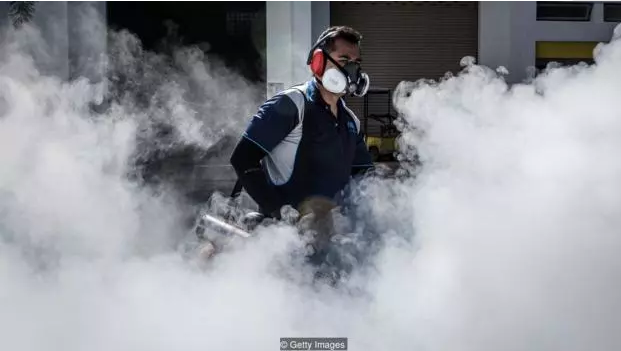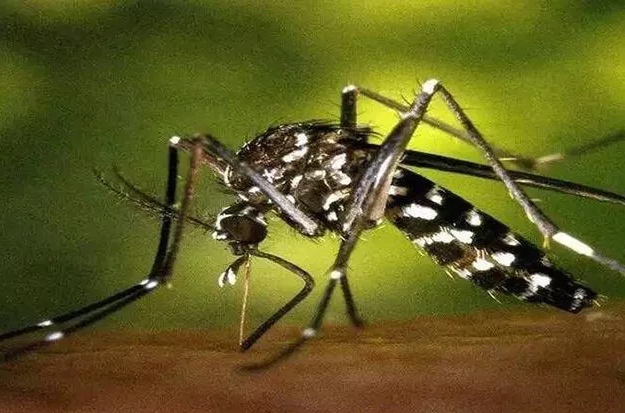The mosquitoes that are fighting dengue and Zika

On a late October morning in a hilly, middle-class neighbourhood in central Singapore, a crowd was forming for a surprising event. Top government officials, community leaders and a throng of media with cameras gathered around a group of scientists who had brought a most unusual gift: boxes of mosquitoes.
10月下旬的一个上午,在新加坡中部一个山坡地的中产阶级社区,一群人正聚集在一起做一件令人惊讶的事。政府官员、社区领袖和一群带着相机的媒体记者聚集在一群科学家身边,科学家带来了一份最不寻常的礼物:一盒蚊子。
With a shout of “one, two, three”, they opened the boxes and released 3,000 of the insects into the air above Singapore’s Braddell Heights. In a country where the warm, tropical climate is ideal for mosquitoes, most people are used to swatting the insects rather than releasing more of them into the environment.
在"一、二、三"的口号声中,他们打开了盒子,将3000只蚊子释放到新加坡的布莱德高地上空。在这个有着蚊子最理想生存气候条件的热带气候国家,大多数人习惯了拍打蚊虫,而不是把更多的蚊子释放到环境中。
Fortunately, the residents of Braddell Heights had been prepared months in advance for this event, and welcomed the release. They knew that the mosquitoes would not bite – and that they were participating in an important study on the impact of mosquitoes infected with Wolbachia, a bacterium that hinders (阻碍)the insects’ fertility and blocks the ability of viruses like Zika to spread.
幸运的是,布莱德高地的居民提前几个月就为这次活动做好了准备,并支持这次释放。他们知道这些蚊子不会叮咬,而且他们正在参与一项重要的研究,研究感染了沃尔巴克氏菌的蚊子对周边的影响,沃尔巴克氏菌会控制昆虫的繁殖能力,阻止像寨卡病毒这样的病毒传播。
Singapore isn’t the only country throwing mosquitoes into the air. Across Asia and Latin America, scientists are trying out radical new methods to defeat Aedes aegypti, and the less widespread Aedes albopictus – the mosquito species that spreads the dengue, chikungunya, and Zika viruses.
新加坡并不是唯一一个将蚊子释放到空中的国家。在亚洲和拉丁美洲,科学家们正在尝试用全新的方法来对付埃及伊蚊,以及不那么普遍的白纹伊蚊,这是几种传播登革热、基孔肯雅热和寨卡病毒的蚊子。
基孔肯雅热(Chikungunya)是由基孔肯雅病毒(CHIKV)引起,经伊蚊传播,以发热、皮疹及关节疼痛为主要特征的急性传染病。
Many of these experiments involve altering mosquitoes in the lab to render them harmless or infertile – with Wolbachia, irradiation, or even genetic modification. But the project in Singapore, along with an even larger trial in Yogyakarta, Indonesia, are showing that the release of these altered insects near human habitation is as much about persuading people about the effectiveness of this approach as it is about scientific innovation.
很多这类实验都涉及到对实验室的蚊子进行改良,通过沃尔巴克氏菌、辐射、亦或基因改良,让它们变得无害或不育。但是,新加坡的这个项目以及在印尼日惹市(Yogyakarta)的一次更大规模的试验,显示在人类居住地附近释放这些改良了的昆虫,不仅事关科学创新,也能让人们明白这种方法的有效性。
This new approach to controlling insects that spread disease – known as biological vectors – began several years ago, when alarm bells first rang over the rise of dengue, today considered the world’s fastest spreading tropical disease. Incidents of dengue have increased 30-fold in the past five decades, according to the World Health Organization. It has expanded from causing severe epidemics in just nine countries before 1970 to more than 100 countries today, many of them in Asia and Latin America.
这种控制传播疾病的昆虫的新方法始于几年前登革热警钟首次响起之时。传播疾病的昆虫又被称为"生物媒介"。今天,登革热被认为是世界上传播速度最快的热带疾病。世界卫生组织的数据显示,在过去50年里,登革热病例增加了30倍。1970年之前,它还只是在9个国家造成严重的疾病传染,现在已经扩大到了超过100个国家,其中许多在亚洲和拉丁美洲。
The recent emergence of Zika, with its frightening links to brain damage in babies, has given experiments in vector control added urgency. There is no treatment yet for either dengue or Zika.
最近出现的寨卡病毒,会对婴儿大脑造成可怕的损伤,这使得病媒控制实验异常紧迫。因为目前还没有针对登革热或寨卡病毒的治疗方法。
病媒生物:指能直接或间接传播疾病(一般指人类疾病),危害、威胁人类健康的生物。
Despite this, there is some reticence among members of the public about projects to tackle the Aedes mosquito. Some of this has its roots in previous attempts to control this deadly insect. In the mid-20th Century, the prevalence of mosquito-borne diseases like malaria and yellow fever led to large-scale sanitation programs and the widespread use of a powerful new insecticide: Dichlorodiphenyltrichloroethane (DDT).
尽管如此,公众对于解决伊蚊的项目还是有所保留,其中部分原因与此前试图控制这种致命昆虫的历史有关。20世纪中叶,面对疟疾和黄热病等蚊子传播疾病的流行,人们采取了大规模的卫生计划,广泛使用一种强力新型杀虫剂:滴滴涕(DDT)。
Dichlorodiphenyltrichloroethane:俗称“DDT”、“滴滴涕”、“二二三”,化学名是“双对氯苯基三氯乙烷”。英文拆分之后是Dichloro(二氯)、diphenyl(苯基苯)、trichloro(三氯)、ethane(乙烷) 。
After widespread use, DDT was eventually banned in 2004 due to concerns over its impact on human health and the environment. It has been linked to cancer in humans and a decline in predatory birds.
在被广泛使用后,滴滴涕最终在2004年被禁用。其原因是它对人类健康和环境造成了影响,造成了人类癌症的增加和食肉性鸟类的减少。
Complacency
自满
Despite this, the use of DDT did reduce numbers of mosquitos. This success led to complacency after the 1970s, says Duane Gubler, emeritus professor of infectious diseases at the Duke-NUS Medical School in Singapore. Brazil, for instance, was declared Aedes-free in 1958 but as measures were relaxed, the insect began to reappear in the 1970s. One genetic study, published in July this year, suggests that mosquitoes from non-eradicated areas in Venezuela recolonised northern Brazil, later expanding their distribution southwards.
不过,滴滴涕的使用还是减少了蚊子的数量。新加坡国立大学杜克医学院传染病学名誉教授杜安·古博尔认为,20世纪70年代之后,这种成功导致了人们的自满。例如,在巴西,1958年宣布伊蚊已经被消灭,但是,随着措施的放宽,这种昆虫在1970年代又重新出现。今年7月发表的一项基因研究表明,来自委内瑞拉未被根除地区的蚊子重新进入了巴西北部,接着又向南方繁殖扩散。
At the same time, Gubler notes, two global trends were nurturing a mosquito comeback. Explosive, chaotic urbanisation created the perfect environment for the city-loving Aedes, as well as providing the perfect conditions for spreading viruses quickly. The growth in global transport and travel also aided their spread to new areas. Treated bed nets, often used to help prevent malaria, are also relatively useless against Aedes, which tends to be active during the day. Growing insecticide resistance added to the problem.
与此同时,古博尔提醒,目前有两种全球趋势正在促成蚊子卷土重来。爆发性的、混乱的城市化进程为喜欢城市环境的伊蚊提供了完美的环境,同时也为病毒的快速传播提供了绝佳的条件。同时,全球运输和旅游的增长也帮助它们实现向其它区域扩展。处理过的蚊帐通常可以用来预防疟疾,但是对伊蚊几乎不起作用,因为伊蚊在白天比较活跃,而它对杀虫剂抗药性的增强又使得问题更加严重。

“We desperately need a range of new tools,” says Gubler, the world’s leading expert on dengue. “Fortunately, many of the ones in the pipeline seem very promising.”
"我们迫切需要找到一些新的办法,"古博尔,这位世界著名的登革热专家说。"幸运的是,很多试验项目带给了人们希望。"
The need is evident even in Singapore, a highly-developed city-state that has had one of the world’s best mosquito control programmes, which has been in operation for over 40 years, yet has recently seen a resurgence in dengue. Singapore looked at an array of new tools, including genetically modified mosquitoes, before settling on trials with Wolbachia.
即使在新加坡这样一个高度发达的城市国家,也有明显的需求。这个国家拥有世界上最好的蚊虫控制方案,该方案已经运作了40多年,但最近登革热又死灰复燃。新加坡研究了一系列新方法,在采用沃尔巴克氏体细菌进行试验之前,还试验过转基因蚊子。
A new weapon
新武器
Described by one scientist as “the biggest thing since DDT”, the use of Wolbachia-infected mosquitoes has become the most widespread of the new vector control experiments, with lab studies or field trials now underway in a dozen countries. The enthusiasm is understandable: Wolbachia seems like the perfect weapon against mosquito-borne disease.
使用经过沃尔巴克氏体感染的蚊子,被一位科学家称作"自滴滴涕以来最重要的事件"。这种方法已经成为新的控制疾病传播媒介实验中最普遍的一种,目前已在十几个国家进行了实验室研究或实地试验。这种热情是可以理解的:因为沃尔巴克氏体细菌似乎是对付蚊子传播疾病的完美武器。
It is found in more than half of all insects, but not usually in viral-pathogen-carrying mosquitoes. The microbe not only protects its host from diseases like dengue and Zika, but is also naturally built to spread rapidly through its host population. Plus, it does not transmit to humans or animals.
在半数以上昆虫中发现了这种细菌,但是,携带有病毒的蚊子中很少见。这种细菌不仅可以保护宿主免受登革热和寨卡等病毒的侵袭,还可以通过宿主群体实现快速传播。此外,它不会传染给人类或动物。
One approach to rolling out this Zika and dengue resistant bacterium, pioneered in 2011 by scientists at Monash University in Australia and propagated through the World Mosquito Program (formerly known as Eliminate Dengue), is to release both male and female Wolbachia-infected mosquitoes into the environment. Wolbachia is only passed from females to their offspring so releasing females with this bacterium means that it will be spread throughout the mosquito population, making them resistant to Zika and dengue.
2011年,澳大利亚莫纳什大学(Monash University)的科学家们发明了一种推广寨卡和登革热抗药性细菌的方法,并通过世界蚊子项目(World Mosquito Program)(此前称作"消灭登革热",Eliminate Dengue)进行宣传推广,即将雄性和雌性的沃尔巴克氏体感染的蚊子释放到环境中。沃尔巴克氏体细菌只从雌性传给后代,因此,释放这种细菌就意味着它将在蚊子种群中传播,使它们不会感染寨卡病毒和登革热。
Ten countries—Australia, Brazil, Colombia, Indonesia, Sri Lanka, India, Vietnam, Kiribati, Fiji and Vanuatu—have signed up for this approach.
已经有10个国家参与使用这一方法,他们是澳大利亚、巴西、哥伦比亚、印度尼西亚、斯里兰卡、印度、越南、基里巴斯、斐济和瓦努阿图。
Singapore, like China, is trying a second approach, aimed at suppressing the population of mosquitoes by releasing only male mosquitoes. Males infected with Wolbachia are unable to fertilise the eggs of non-infected females.
和中国一样,新加坡正在尝试第二种方法,目标是只释放雄性蚊子,以控制蚊子的数量。感染了沃尔巴克氏体的雄性蚊子无法使未感染的雌性受精。
The method chosen is partly to do with cost. The second approach is more expensive because it involves sorting males from females in the lab and, unlike the first approach, requires sustained release of mosquitoes – at least until the population crashes, and perhaps even afterwards. Last year, following successful trials, China set up facilities in Guangzhou to produce five million Wolbachia-infected mosquitoes a week.
选择哪一种方法在一定程度上与成本有关。第二种方法更昂贵,因为它需要在实验室里将雄性与雌性分拣出来,而且不像第一种方法,需要至少在种群崩溃之前甚至之后持续释放蚊子。去年,在成功进行试验之后,中国在广州设立了工厂,每周生产500万只感染有沃尔巴克氏细菌的蚊子。
Public acceptance also plays a critical role in the choice of technology used, as scientists have learnt from past controversies, not only with DDT, but also unsuccessful trials of sterilised mosquitoes in India in the 1970s, which led to public panic over the chemicals being used.
公众的接受程度对选择哪些技术也起着重要的作用。根据以往争论的经验,科学家们意识到,无论是滴滴涕,还是20世纪70年代的印度不成功的蚊子绝育试验,都导致了公众对所使用的化学物质的恐慌感。
Lee Chen Ng, the director of the Environmental Health Institute at Singapore’s National Environment Agency and head of its Wolbachia project, says they chose the suppression approach in part because male mosquitoes don’t bite, making it more acceptable to Singaporeans. It’s also in keeping with the country’s tough house-to-house checks on mosquito breeding that keeps bug numbers low.
新加坡国家环境局环境卫生研究所所长、沃尔巴克氏菌项目负责人Lee Chen Ng表示,他们之所以选择这种控制方式,部分是因为雄性蚊子不咬人,这让新加坡人更容易接受。这也与该国严格的逐家逐户检查蚊子繁殖进而保持蚊子数量处于低水平的做法相一致。
Using Wolbachia to suppress mosquito breeding should also be seen as less risky than previous attempts because the bacteria already exists in the environment, suggests Ng. It has been found to be safe for humans and animals, although long-term ecological effects are not known. Trials of genetically modified mosquitoes were rejected by a community in southern United States last year, while Wolbachia trials proceeded with little fuss. In November, Wolbachia-infected mosquitoes were cleared for release by the US Environment Protection Authority in 20 states.
Lee Chen Ng说,使用沃尔巴克氏菌来抑制蚊子的繁殖,也应该被认为比此前的尝试风险小,因为这种细菌已经存在于环境中。人们发现它对人类和动物都是安全的,虽然长期的生态效应还不为人所知。去年美国南部的一个社区拒绝了转基因蚊子的试验,不过,沃尔巴克氏菌试验的进展几乎没有受到影响。11月,美国20个州的环境保护部门批准了感染沃尔巴克氏病毒的蚊子的释放。
Engagement
社区参与
Nowhere is the importance of community more evident than in the low-rise city of Yogyakarta in Java, Indonesia, where Asia’s largest Wolbachia trial is underway. Adi Utarini, the project head and professor of public health at Gadjah Mada University, says their trial is not only about technological innovation but also community engagement.
社区的重要性在位于印度尼西亚爪哇岛上的房屋低矮的城市日惹(Yogyakarta)极为明显,为任何地方所不及。这儿,亚洲最大规模的沃尔巴克氏菌试验正在进行。加扎马达大学(Gadjah Mada University)公共卫生项目负责人、教授阿迪·乌塔里尼(Adi Utarini)说,他们的试验不仅事关技术创新,也关系到社区参与。
“People think this is a lab project but it only starts in the lab, the insectary,” she says. “To bring this technology into the community is as much a challenge… because, in the end, it’s the community that decides whether they want this technology or not.”
"人们认为这是一个实验室项目,但它只是始于—培育蚊虫,"她说,"将这一技术引入社区同样是个挑战…因为,最后,是社区决定他们是否希望采用这项技术。"
Utarini and her team began in 2011 by importing infected eggs from Australia’s Monash University. For the next two years, they worked in the lab, testing and breeding Wolbachia mosquitoes. At the same time, their communications head Bekti Andari began visiting communities in the district of Sleman, where the first release would take place.
从2011年开始,乌塔利尼和她的团队就从澳大利亚莫纳什大学进口经过感染的虫卵。在接下来的两年里,他们在实验室里测试并培育了沃尔巴克氏菌蚊子。与此同时,他们的公关负责人贝克提·安得利(Bekti Andari)开始在斯勒曼(Sleman)地区的社区进行访问,因为第一次释放将在那里进行。
The first challenge they faced, says Utarini, was having to tell people “the opposite of what they are used to believing: that you have to get rid of mosquitoes”. They had to educate people about the basics of disease transmission, to make them understand that “the enemy is not the mosquito, the enemy is the virus”.
乌塔利尼说,他们面临的第一个挑战是,必须告诉人们"与他们过去的观点,你必须消灭蚊子所相反的理念"。他们必须传授人们有关疾病传播的基本知识,让他们明白"敌人不是蚊子,敌人是病毒"。
The Sleman experience shaped the rest of the project. After releasing adult mosquitoes in Sleman – including biting females – the team switched to containers of Wolbachia-infected eggs. Eggs were an easier sell to the public. They were less obtrusive as the insects hatched and flew out at different times. It also meant releases could be made more frequently.
斯勒曼的经验决定了项目的其余部分。在斯勒曼地区将成年蚊子(包括咬人的雌性蚊子)释放后,研究小组转而采用装有感染沃尔巴克氏菌卵子的容器。使用虫卵更容易向公众解释和说明。因为它们不像孵化好的蚊虫出来时那样惹眼,而是分不同的时段分批成熟和往外飞。同时,这也意味着可以更频繁地释放。
The researchers also hit upon another strategy to keep residents on-side – giving them their own containers of eggs to take care of. Having the mosquito containers in their own back gardens made people curious about the process and also motivated them to keep their mosquito container safe.
研究人员不经意间还发现了另一种获得居民支持的策略——将盛有虫卵的容器交给居民自己来照看。将盛有蚊卵的容器放在自家后院,会让人们对这一过程产生好奇,并刺激他们保持蚊子容器的安全。
As the trial slowly expanded through Yogyakarta, the team used all the tools at their disposal: community meetings, neighbourhood newsletters, mass media, phone calls and emails, visits to the lab.
随着试验慢慢扩展至全日惹,团队采用了所有能获得的手段:社区会议、社区简报、大众媒体、电话和电子邮件、以及参观实验室。
“We hid nothing from people,” says Utarini. “Challenges had to be continually met.” In one neighbourhood, the team had to briefly stop work during the dengue season because of panic over an outbreak of cases that affected 14 patients and led to one death. The team returned after people were calmer.
"我们从来不向人们隐瞒什么,"乌塔里尼说,"必须不断面对和克服挑战"。在一个社区,由于14名患者感染疫情并有一人死亡,人们产生了恐慌,团队不得不在登革热季短暂停止了工作。待人们平静下来之后,这个团队又回来了。
Between 2015 and 2017, half of the Yogyakarta’s 24 districts were inundated with Wolbachia mosquitoes. The other half served as the control, made possible by the fact that mosquitoes don’t fly too far.
2015年至2017年间,日惹的24个社区中有一半布满了被沃尔巴克氏菌蚊子。另外一半则是作为试验对照组,能这样做是因为蚊子不会飞得太远。
By mid-2017, scientists had placed thousands of containers of eggs in backyards – one every 50 metres (164ft). Every two weeks they were refreshed with up to 120 new eggs. The scientists are now waiting for Wolbachia to expand to 80% of the mosquito population to see whether the releases are having the impact on the prevalence of dengue they predicted.
截止2017年年中,科学家已经在居民家庭后院放置了数千个虫卵容器,每50米(164英尺)就有一个。这些容器每两周会补充更新多达120个新卵。科学家们正在期待沃尔巴克氏菌传播到80%的蚊子,以确定释放虫卵是否如他们所预期的对登革热流行产生影响。
A good result, says Utarini, would be if the number of cases in Wolbachia areas is 50% less than control areas.
乌塔利尼认为,如果释放沃尔巴克氏菌蚊子地区的发病病例比对照组低50%,结果就很良好。
“That’s when we can say this works,” she says.
"到那时候,我们就可以宣称这样做是起作用的,"她说。
Meanwhile, in Singapore, the early results have been promising. Ng and her team found Wolbachia mosquitoes survive as well as wild mosquitoes in the urban environment, flying to upper floors, and successfully mating with the non-Wolbachia females. The viability of eggs collected from the study sites had fallen by half. Now, says Ng, they are looking at scaling up mosquito production and strategies of release.
与此同时,新加坡的早期成果也很鼓舞人心。Lee Chen Ng和她的团队发现,沃尔巴克氏菌蚊子和野蚊子都能在城市环境中存活,并能飞到楼上、成功地与非沃尔巴克氏菌雌性蚊子交配。从研究地点采集的卵子的存活率下降了一半。Lee Chen Ng说,现在他们正在考虑扩大蚊子的生产和释放策略。
Neither Ng nor Utarini believe Wolbachia is a silver bullet for Zika or dengue. But a mix of interventions could do the trick.
无论是Lee Chen Ng还是乌塔利尼,他们没有人认为沃尔巴克氏细菌是对付寨卡病毒或登革热的灵丹妙药。但是,采取混合干预可能会起作用。
“If we can use new vaccines [for dengue and Zika] to increase herd immunity, and at the same time, new tools like Wolbachia and insecticides to reduce the mosquito population, we should be able to control these diseases,” says Gubler.
"如果我们能使用新疫苗(登革热和寨卡病毒)来增加群体免疫力,同时,采取像沃尔巴克氏菌和杀虫剂这样的新工具来减少蚊子的数量,我们就应该能够控制这类疾病,"古博尔说。











